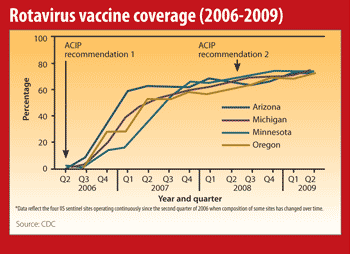Rotavirus vaccination coverage increased from 2006 to 2009
Rotavirus vaccination coverage among infants increased to nearly 75% during a recent three-year period, but rates continue to lag behind other childhood vaccinations, according to study results.
CDC officials conducted an analysis of data from Immunization Information System sentinel sites in Arizona, Colorado, Michigan, Minnesota, New York City, North Dakota, Oregon and Wisconsin.
The aim of the analysis was to assess trends in coverage with at least one dose of the rotavirus vaccine from June 2006 to June 2009 among infants aged 5 months. The researchers also sought to compare rotavirus vaccination coverage with that of the diphtheria and tetanus toxoids and acellular pertussis vaccine and the pneumococcal conjugate vaccine seven-valent among 5-month-old infants for the second quarter of 2009.

After introduction in 2006, coverage with at least one dose of the vaccine among infants enrolled at the four continuously serving sentinel sites increased to about 50% to 60% within the first year and then at a rate of about 2.7% per quarter thereafter — reaching a rate of 74% by the second quarter of 2009.
Data from June 30, 2009 indicated that there were 23,532 infants aged 5 months enrolled at the eight sentinel sites (range, 164 to 11,767 infants per site). There was an average rotavirus vaccination rate of 72% among the infants.
However, coverage with at least one dose of the rotavirus vaccine was 13 percentage points lower than the average coverage with at least one dose of DTaP and PCV7 at the same sites, according to the results.
Site-based results indicated that coverage ranged from 48% in Colorado to 86% in North Dakota.
Possible explanations for the difference could be typical new vaccine coverage dynamics, the presence of barriers specific to the rotavirus vaccine or both. The researchers encouraged clinicians to identify and reduce potential barriers to rotavirus vaccination. – by Rob Volansky
Bartlett DL. MMWR. 2010; 59:521-524.
